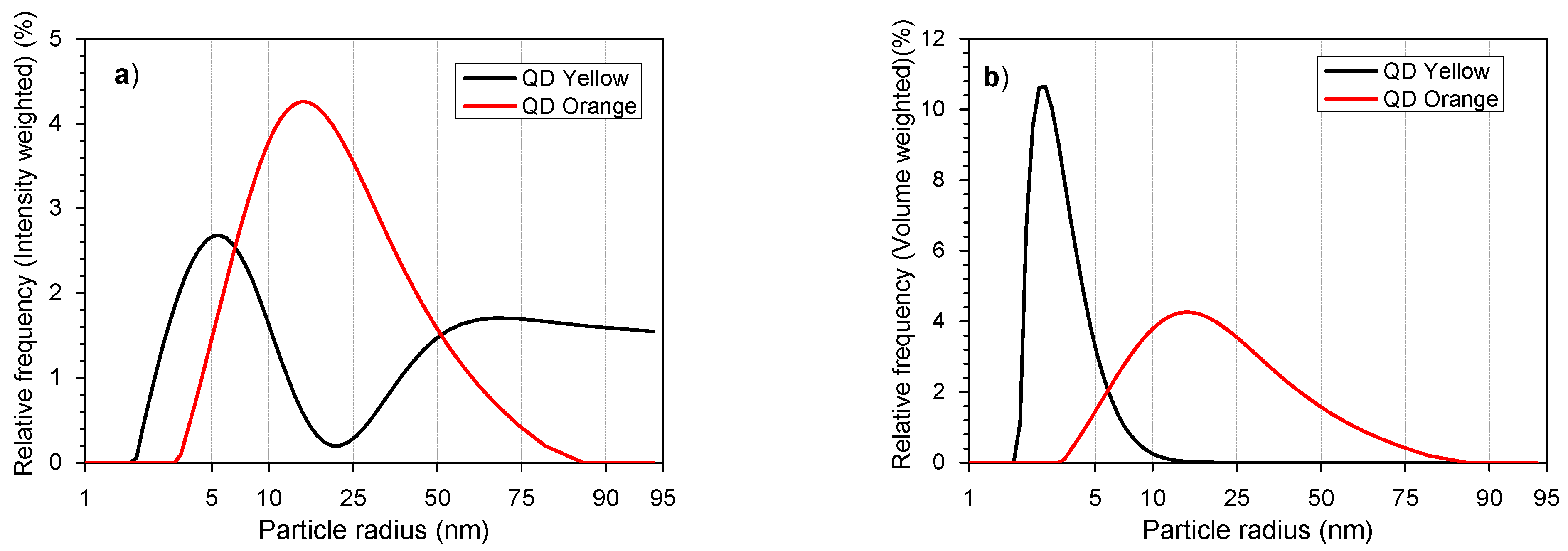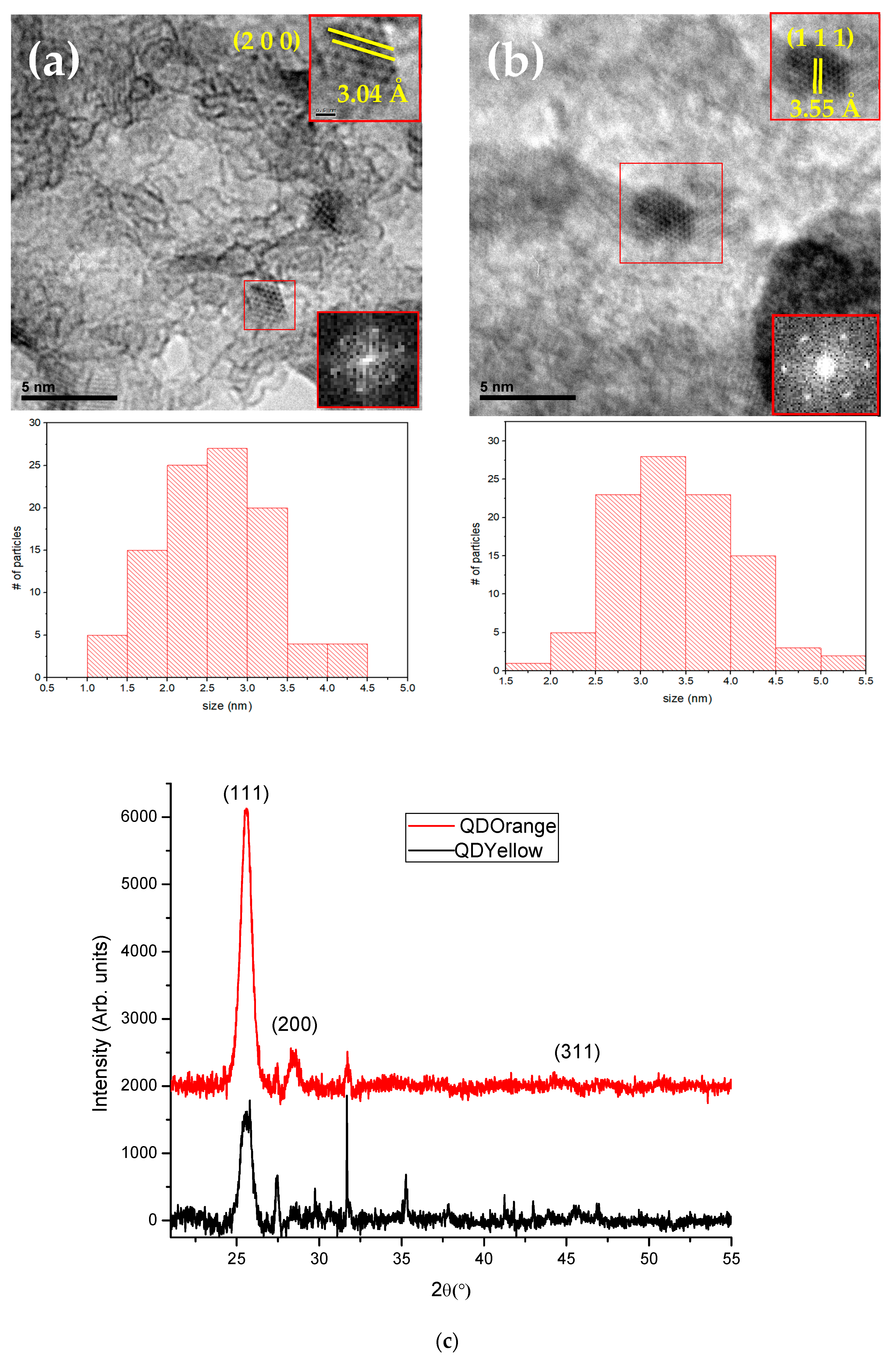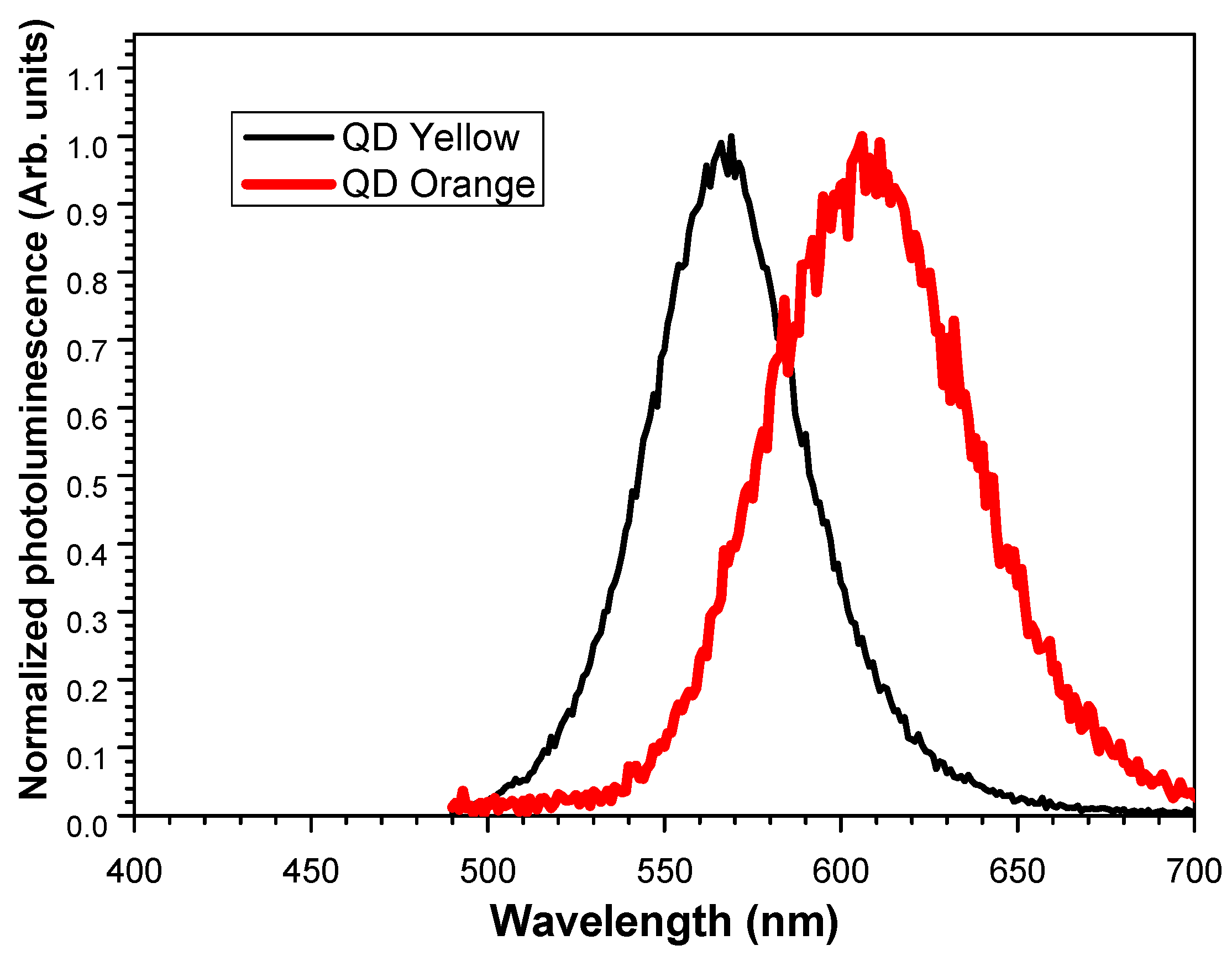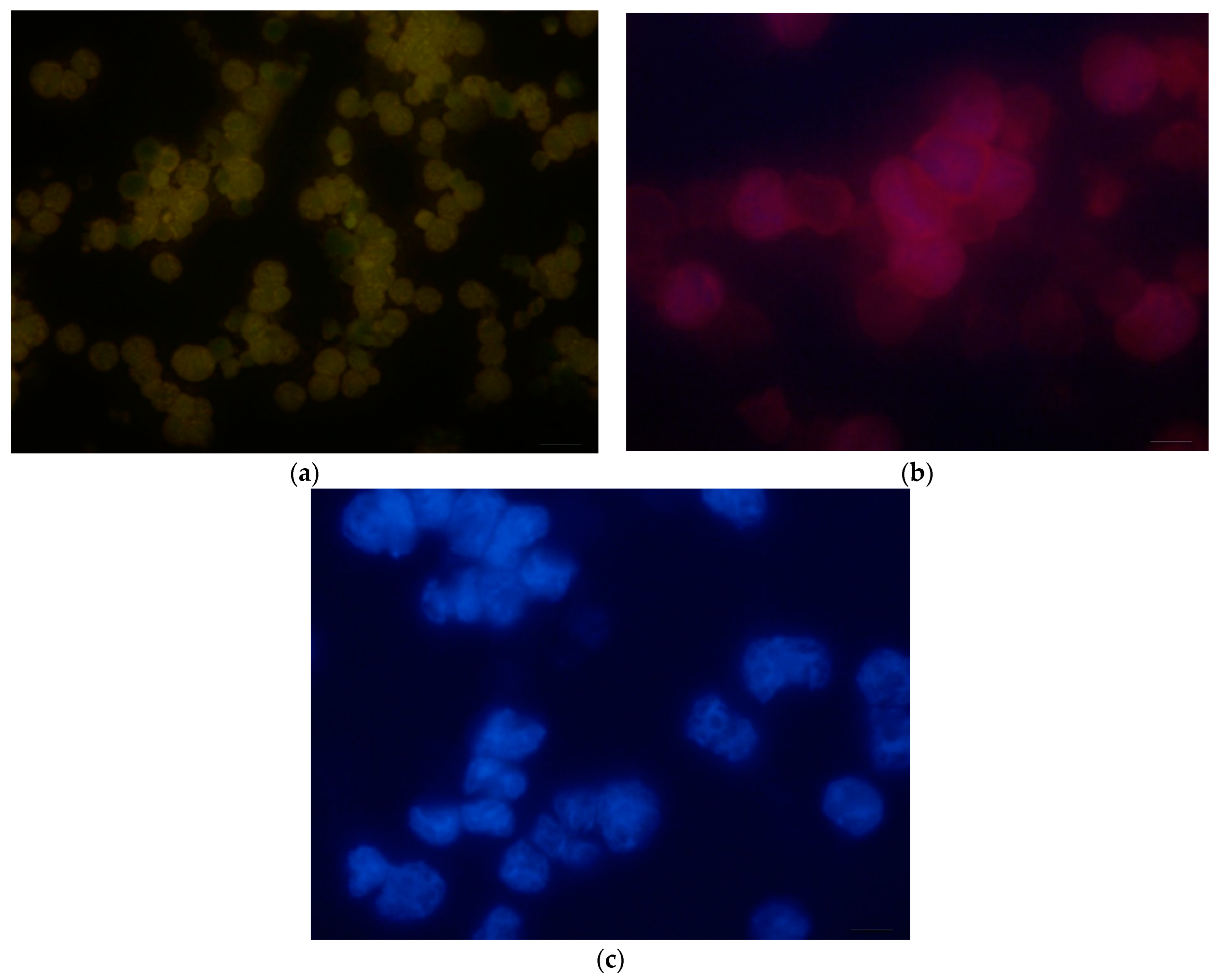Physico-Chemical Properties of CdTe/Glutathione Quantum Dots Obtained by Microwave Irradiation for Use in Monoclonal Antibody and Biomarker Testing
Abstract
1. Introduction
2. Experimental Procedure
2.1. Materials
2.2. Synthesis of CdTe-GSH Quantum Dots
2.3. Optical Absorbance Spectroscopy
2.4. Dynamic, Static and Electrophoretic Light Scattering
2.5. Transmission Electron Microscopy (TEM) and X-ray Diffraction (XRD)
2.6. Photoluminescence Spectroscopy
2.7. FT-IR Spectroscopy
2.8. Atomic Emission Spectroscopy (AES)
3. Results and Discussion
3.1. Particle Size
3.2. Transmission Electron Microscopy and X-ray Diffraction
3.3. Molecular Weight
3.4. Fourier-Transform Infrared Spectroscopy (FT-IR)
3.5. Zeta Potential
3.6. Optical Absorbance Spectroscopy (UV-Vis)
3.7. Photoluminescence
3.8. Inductively Coupled Plasma–Atomic Emission Spectrometry (ICP-OES)
4. Conclusions
Author Contributions
Funding
Data Availability Statement
Conflicts of Interest
References
- Vassiltsova, O.; Jayez, D.; Zhao, Z.; Carpenter, M.; Petrukhina, M. Synthesis of nanocomposite materials with controlled structures and optical emissions: Application of various methacrylate polymers for CdSe quantum dots encapsulation. J. Nanosci. Nanotechnol. 2010, 10, 1635–1642. [Google Scholar] [CrossRef] [PubMed]
- Zhou, Y.; Zhao, H.; Ma, D.; Rosei, F. Harnessing the properties of colloidal quantum dots in luminescent solar concentrators. Chem. Soc. Rev. 2018, 47, 5866–5890. [Google Scholar] [CrossRef] [PubMed]
- Morselli, G.; Villa, M.; Fermi, A.; Critchley, K.; Ceroni, P. Luminescent copper indium sulfide (CIS) quantum dots for bioimaging applications. Nanoscale Horiz. 2021, 6, 676–695. [Google Scholar] [CrossRef] [PubMed]
- Chaturvedi, V.K.; Singh, A.; Singh, V.K.; Singh, M.P. Cancer nanotechnology: A new revolution for cancer diagnosis and therapy. Curr. Drug Metab. 2019, 20, 416–429. [Google Scholar] [CrossRef] [PubMed]
- Barbosa, M.E.M.; Montembault, V.; Cammas-Marion, S.; Ponchel, G.; Fontaine, L. Synthesis and characterization of novel poly(γ-benzyl-L-glutamate) derivatives tailored for the preparation of nanoparticles of pharmaceutical interest. Polym. Int. 2007, 56, 317–324. [Google Scholar] [CrossRef]
- Valencia, C.A.Z.; Valderrama, M.I.R.; Carbajal, A.D.J.H.; Rodríguez, E.S.; Lugo, V.R. Evaluación de la lumiscencia de puntos cuánticos de carbono sintetizados mediante el método hidrotermal a partir de triticum. Pädi Boletín Científico De Cienc. Básicas E Ing. Del ICBI 2019, 7, 19–22. [Google Scholar] [CrossRef]
- Farzin, M.A.; Abdoos, H. A critical review on quantum dots: From synthesis toward applications in electrochemical biosensors for determination of disease-related biomolecules. Talanta 2021, 224, 121828. [Google Scholar] [CrossRef] [PubMed]
- Sobhanan, J.; Rival, J.V.; Anas, A.; Shibu, E.S.; Takano, Y.; Biju, V. Luminescent Quantum Dots: Synthesis, Optical Properties, Bioimaging and Toxicity. Adv. Drug Deliv. Rev. 2023, 197, 114830. [Google Scholar] [CrossRef] [PubMed]
- Chinen, A.B.; Guan, C.M.; Ferrer, J.R.; Barnaby, S.N.; Merkel, T.J.; Mirkin, C.A. Nanoparticle probes for the detection of cancer biomarkers, cells, and tissues by fluorescence. Chem. Rev. 2015, 115, 10530–10574. [Google Scholar] [CrossRef]
- Li, P.; Liu, S.; Yan, S.; Fan, X.; He, Y. A sensitive sensor for anthraquinone anticancer drugs and hsDNA based on CdTe/CdS quantum dots fluorescence reversible control. Colloids Surfaces A Physicochem. Eng. Asp. 2011, 392, 7–15. [Google Scholar] [CrossRef]
- Norris, D.J.; Nirmal, M.; Murray, C.B.; Sacra, A.; Bawendi, M.G. Size dependent optical spectroscopy of II–VI semiconductor nanocrystallites (quantum dots). Eur. Phys. J. D 1993, 26, 355–357. [Google Scholar] [CrossRef]
- Minelli, C.; Lowe, S.B.; Stevens, M.M. Engineering nanocomposite materials for cancer therapy. Small 2010, 6, 2336–2357. [Google Scholar] [CrossRef]
- Rojas-Valencia, O.G.; Díaz-Santiago, D.L.; Casas-Espínola, J.L.; Reza-San-Germán, C.M.; Estrada-Flores, M.; Torres-Santillán, E. Síntesis de partículas luminiscentes de carbono a partir de la carbonización de Beta Vulgaris (betabel). Pädi Boletín Científico De Cienc. Básicas E Ing. Del ICBI 2023, 10, 80–84. [Google Scholar] [CrossRef]
- Chang, Q.; Meng, T.; Tan, H. Preparation and fluorescence characteristics of CdTe/CdS and CdTe/ZnS core-shell semiconductor quantum dots. Infrared Laser Eng. 2021, 50, 1–7. [Google Scholar] [CrossRef]
- Triana, M.A.; López, A.F.; Camargo, R.J. Síntesis, Caracterización y Evaluación Fotocatalítica de Puntos cuánticos de CdSe cubiertos con 2 tipos de Tioles. Inf. Tecnol. 2015, 26, 121–134. [Google Scholar] [CrossRef][Green Version]
- Díaz González, M.; de la Escosura Muñiz, A.; Fernandez Argüelles, M.T.; Alonso, F.J.G.; Costa Fernandez, J.M. Quantum dot bioconjugates for diagnostic applications. In Surface-Modified Nanobiomaterials for Electrochemical and Biomedicine Applications; Springer: Cham, Switzerland, 2020; pp. 133–176. [Google Scholar] [CrossRef]
- Dos Santos, G.A.; Capelo, R.G.; Liu, C.; Manzani, D. In-situ synthesis of luminescent CdS quantum dots embedded in phosphate glass. J. Non-Cryst. Solids 2022, 587, 121599. [Google Scholar] [CrossRef]
- Kairdolf, B.A.; Smith, A.M.; Stokes, T.H.; Wang, M.D.; Young, A.N.; Nie, S. Semiconductor quantum dots for bioimaging and biodiagnostic applications. Annu. Rev. Anal. Chem. 2013, 6, 143–162. [Google Scholar] [CrossRef] [PubMed]
- Zhang, L.-J.; Xia, L.; Xie, H.-Y.; Zhang, Z.-L.; Pang, D.-W. Quantum dot based biotracking and biodetection. Anal. Chem. 2018, 91, 532–547. [Google Scholar] [CrossRef]
- Zhou, J.; Pu, C.; Jiao, T.; Hou, X.; Peng, X. A two-step synthetic strategy toward monodisperse colloidal CdSe and CdSe/CdS core/shell nanocrystals. J. Am. Chem. Soc. 2016, 138, 6475–6483. [Google Scholar] [CrossRef]
- Chen, P.E.; Anderson, N.C.; Norman, Z.M.; Owen, J.S. Tight binding of carboxylate, phosphonate, and carbamate anions to stoichiometric CdSe nanocrystals. J. Am. Chem. Soc. 2017, 139, 3227–3236. [Google Scholar] [CrossRef]
- Luo, D.; Han, R.; Chen, Y.; Zheng, Q.; Wang, L.; Hong, Y.; Sha, Y. Design and Fabrication of a Geometrically Ordered Hydrophobic Interlayer to Prepare High-Quality QD/SiO2 for Cell Imaging. J. Biomed. Nanotechnol. 2017, 13, 1344–1353. [Google Scholar] [CrossRef]
- Karaagac, Z.; Gul, O.T.; Ildiz, N.; Ocsoy, I. Transfer of hydrophobic colloidal gold nanoparticles to aqueous phase using catecholamines. J. Mol. Liq. 2020, 315, 113796. [Google Scholar] [CrossRef]
- Silva, F.O.; Carvalho, M.S.; Mendonça, R.; Macedo, W.A.; Balzuweit, K.; Reiss, P.; Schiavon, M.A. Effect of surface ligands on the optical properties of aqueous soluble CdTe quantum dots. Nanoscale Res. Lett. 2012, 7, 536. [Google Scholar] [CrossRef] [PubMed]
- Monrás, J.P.; Díaz, V.; Bravo, D.; Montes, R.A.; Chasteen, T.G.; Osorio-Román, I.O.; Vásquez, C.C.; Pérez-Donoso, J.M. Enhanced glutathione content allows the in vivo synthesis of fluorescent CdTe nanoparticles by Escherichia coli. PLoS ONE 2012, 7, e48657. [Google Scholar] [CrossRef] [PubMed]
- Subramanian, S.; Ganapathy, S.; Rajaram, M.; Ayyaswamy, A. Tuning the optical properties of colloidal quantum dots using thiol group capping agents and its comparison. Mater. Chem. Phys. 2020, 249, 123127. [Google Scholar] [CrossRef]
- Wang, L.; Xu, D.; Gao, J.; Chen, X.; Duo, Y.; Zhang, H. Semiconducting quantum dots: Modification and applications in biomedical science. Sci. China Mater. 2020, 63, 1631–1650. [Google Scholar] [CrossRef]
- Dogar, A.H.; Ullah, S.; Qayyum, H.; Rehman, Z.U.; Qayyum, A. Characterization of charge and kinetic energy distribution of ions emitted during nanosecond pulsed laser ablation of several metals. J. Phys. D Appl. Phys. 2017, 50, 385602. [Google Scholar] [CrossRef]
- Ju, J.; Zhang, R.; Chen, W. Photochemical deposition of surface-clean silver nanoparticles on nitrogen-doped graphene quantum dots for sensitive colorimetric detection of glutathione. Sensors Actuators B Chem. 2016, 228, 66–73. [Google Scholar] [CrossRef]
- Baig, M.S.; Suryawanshi, R.M.; Zehravi, M.; Mahajan, H.S.; Rana, R.; Banu, A.; Subramanian, M.; Kaundal, A.K.; Puri, S.; Siddiqui, F.A.; et al. Surface decorated quantum dots: Synthesis, properties and role in herbal therapy. Front. Cell Dev. Biol. 2023, 11, 1139671. [Google Scholar] [CrossRef]
- Wang, Z.; Xing, X.; Yang, Y.; Zhao, R.; Zou, T.; Wang, Z.; Wang, Y. One-step hydrothermal synthesis of thioglycolic acid capped CdS quantum dots as fluorescence determination of cobalt ion. Sci. Rep. 2018, 8, 8953. [Google Scholar] [CrossRef]
- Al Rifai, N.; Desgranges, S.; Le Guillou-Buffello, D.; Giron, A.; Urbach, W.; Nassereddine, M.; Charara, J.; Contino-Pépin, C.; Taulier, N. Ultrasound-triggered delivery of paclitaxel encapsulated in an emulsion at low acoustic pressures. J. Mater. Chem. B 2020, 8, 1640–1648. [Google Scholar] [CrossRef]
- Gil, H.M.; Price, T.W.; Chelani, K.; Bouillard, J.-S.G.; Calaminus, S.D.; Stasiuk, G.J. NIR-quantum dots in biomedical imaging and their future. iScience 2021, 24, 102189. [Google Scholar] [CrossRef]
- Jeong, S.; Jung, Y.; Bok, S.; Ryu, Y.; Lee, S.; Kim, Y.; Song, J.; Kim, M.; Kim, S.; Ahn, G.; et al. Multiplexed In Vivo Imaging Using Size-Controlled Quantum Dots in the Second Near-Infrared Window. Adv. Health Mater. 2018, 7, e1800695. [Google Scholar] [CrossRef] [PubMed]
- Gautier, J.; Monrás, J.; Osorio-Román, I.; Vásquez, C.; Bravo, D.; Herranz, T.; Marco, J.; Pérez-Donoso, J. Surface characterization of GSH-CdTe quantum dots. Mater. Chem. Phys. 2013, 140, 113–118. [Google Scholar] [CrossRef]
- Gerbec, J.A.; Magana, D.; Washington, A.; Strouse, G.F. Microwave-enhanced reaction rates for nanoparticle synthesis. J. Am. Chem. Soc. 2005, 127, 15791–15800. [Google Scholar] [CrossRef]
- Hu, M.Z.; Zhu, T. Semiconductor Nanocrystal quantum dot synthesis approaches towards large-scale industrial production for energy applications. Nanoscale Res. Lett. 2015, 10, 469. [Google Scholar] [CrossRef] [PubMed]
- Singh, S.; Sabri, Y.M.; Jampaiah, D.; Selvakannan, P.; Nafady, A.; Kandjani, A.E.; Bhargava, S.K. Easy, one-step synthesis of CdTe quantum dots via microwave irradiation for fingerprinting application. Mater. Res. Bull. 2017, 90, 260–265. [Google Scholar] [CrossRef]
- Zhu, J.; Palchik, O.; Chen, S.; Gedanken, A. Microwave assisted preparation of CdSe, PbSe, and Cu2-xSe nanoparticles. J. Phys. Chem. B 2000, 104, 7344–7347. [Google Scholar] [CrossRef]
- Ziegler, J.; Merkulov, A.; Grabolle, M.; Resch-Genger, U.; Nann, T. High-Quality ZnS Shells for CdSe Nanoparticles: Rapid Microwave Synthesis. Langmuir 2007, 23, 7751–7759. [Google Scholar] [CrossRef]
- Kagan, C.R.; Bassett, L.C.; Murray, C.B.; Thompson, S.M. Colloidal quantum dots as platforms for quantum information science. Chem. Rev. 2020, 121, 3186–3233. [Google Scholar] [CrossRef] [PubMed]
- Lai, L.; Li, S.-J.; Feng, J.; Mei, P.; Ren, Z.-H.; Chang, Y.-L.; Liu, Y. Effects of surface charges on the bactericide activity of Cdte/Zns quantum dots: A cell membrane disruption perspective. Langmuir 2017, 33, 2378–2386. [Google Scholar] [CrossRef]
- Antony, J.V.; Pillai, J.J.; Kurian, P.; Nampoori, V.P.N.; Kochimoolayil, G.E. Photoluminescence and optical nonlinearity of CdS quantum dots synthesized in a functional copolymer hydrogel template. New J. Chem. 2017, 41, 3524–3536. [Google Scholar] [CrossRef]
- Rabadanov, M.K.; Verin, I.A.; Ivanov, Y.M.; Simonov, V.I. Refinement of the atomic structure of CdTe single crystals. Crystallogr. Rep. 2001, 46, 636–641. [Google Scholar] [CrossRef]
- Belenkii, D.I.; Averkin, D.V.; Vishnevetskii, D.V.; Khizhnyak, S.D.; Pakhomov, P.M. Development and Creation of a Zeta Potential Reference Material of Particles in a Liquid Medium. Meas. Technol. 2021, 64, 328–332. [Google Scholar] [CrossRef]
- Gómez-Piñeros, B.S.; Granados-Oliveros, G. Síntesis y caracterización de las propiedades ópticas de puntos cuánticos de CdSe y CdSe/ZnS. Rev. Colomb. De Química 2018, 47, 57–63. [Google Scholar] [CrossRef]
- Silva-Vidaurri, L.G.; Ruiz-Robles, M.A.; Gutiérrez-Lazos, C.D.; Solis-Pomar, F.; Fundora, A.; Meléndrez, M.F.; Pérez-Tijerina, E. Study of the influence of microwave irradiation under controlled conditions on the optical and structural properties of CdTe quantum dots synthesized by one-pot synthesis. Chalcogenide Lett. 2019, 16, 241–248. [Google Scholar]
- Pan, J.; Zheng, Z.; Yang, J.; Wu, Y.; Lu, F.; Chen, Y.; Gao, W. A novel and sensitive fluorescence sensor for glutathione detection by controlling the surface passivation degree of carbon quantum dots. Talanta 2017, 166, 1–7. [Google Scholar] [CrossRef] [PubMed]
- Qu, Z.; Li, N.; Na, W.; Su, X. A novel fluorescence “turn off–on” nanosensor for sensitivity detection acid phosphatase and inhibitor based on glutathione-functionalized graphene quantum dots. Talanta 2019, 192, 61–68. [Google Scholar] [CrossRef] [PubMed]
- Wang, Y.; Feng, M.; He, B.; Chen, X.; Zeng, J.; Sun, J. Ionothermal synthesis of carbon dots from cellulose in deep eutectic solvent: A sensitive probe for detecting Cu2+ and glutathione with “off-on” pattern. Appl. Surf. Sci. 2022, 599, 153705. [Google Scholar] [CrossRef]
- Chen, X.; Guo, Z.; Miao, P. One-pot synthesis of GSH-Capped CdTe quantum dots with excellent biocompatibility for direct cell imaging. Heliyon 2018, 4, e00576. [Google Scholar] [CrossRef]
- Ruiz-Robles, M.A.; Solis-Pomar, F.; Gutiérrez-Lazos, C.D.; Fundora-Cruz, A.; Mayoral, Á.; Pérez-Tijerina, E. Synthesis and characterization of polymer/silica/QDs fluorescent nanocomposites with potential application as printing toner. Mater. Res. Express 2018, 6, 025314. [Google Scholar] [CrossRef]
- Kini, S.; Kulkarni, S.D.; Ganiga, V.; Nagarakshit, T.K.; Chidangil, S. Dual functionalized, stable and water dispersible CdTe quantum dots: Facile, one-pot aqueous synthesis, optical tuning and energy transfer applications. Mater. Res. Bull. 2019, 110, 57–66. [Google Scholar] [CrossRef]
- Qian, H.; Dong, C.; Weng, J.; Ren, J. Facile One-Pot Synthesis of Luminescent, Water-Soluble, and Biocompatible Glutathione-Coated CdTe Nanocrystals. Small 2006, 2, 747–751. [Google Scholar] [CrossRef] [PubMed]
- Wansapura, P.T.; Díaz-Vásquez, W.A.; Vásquez, C.C.; Pérez-Donoso, J.M.; Chasteen, T.G. Thermal and photo stability of glutathione-capped cadmium telluride quantum dots. J. Appl. Biomater. Funct. Mater. 2015, 13, 248–252. [Google Scholar] [CrossRef] [PubMed]
- Kim, C.; Deratani, A.; Bonfils, F. Determination of the refractive index increment of natural and synthetic poly(cis-1,4-isoprene) solutions and its effect on structural parameters. J. Liq. Chromatogr. Relat. Technol. 2009, 33, 37–45. [Google Scholar] [CrossRef]
- Li, X.; Wang, C.; Ma, L.; Liu, L. Ellipsometry-transmission measurement of the complex refractive indices for a series of organic solvents in the 200–1700 nm spectral range. Infrared Phys. Technol. 2022, 125, 104313. [Google Scholar] [CrossRef]
- Alibolandi, M.; Abnous, K.; Ramezani, M.; Hosseinkhani, H.; Hadizadeh, F. Synthesis of AS1411-aptamer-conjugated CdTe quantum dots with high fluorescence strength for probe labeling tumor cells. J. Fluoresc. 2014, 24, 1519–1529. [Google Scholar] [CrossRef] [PubMed]
- Rogach, A.L.; Franzl, T.; Klar, T.A.; Feldmann, J.; Gaponik, N.; Lesnyak, V.; Shavel, A.; Eychmüller, A.; Rakovich, Y.P.; Donegan, J.F. Aqueous Synthesis of Thiol-Capped CdTe Nanocrystals: State-of-the-Art. J. Phys. Chem. C 2007, 111, 14628–14637. [Google Scholar] [CrossRef]
- Spittel, D.; Poppe, J.; Meerbach, C.; Ziegler, C.; Hickey, S.G.; Eychmüller, A. Absolute energy level positions in CdSe nanostructures from potential-modulated absorption spectroscopy (EMAS). ACS Nano 2017, 11, 12174–12184. [Google Scholar] [CrossRef]
- Pietryga, J.M.; Park, Y.-S.; Lim, J.; Fidler, A.F.; Bae, W.K.; Brovelli, S.; Klimov, V.I. Spectroscopic and device aspects of nanocrystal quantum dots. Chem. Rev. 2016, 116, 10513–10622. [Google Scholar] [CrossRef]
- Zhang, M.; Yue, J.; Cui, R.; Ma, Z.; Wan, H.; Wang, F.; Dai, H. Bright quantum dots emitting at ~1600 nm in the NIR-IIb window for deep tissue fluorescence imaging. Proc. Natl. Acad. Sci. USA 2018, 115, 6590–6595. [Google Scholar] [CrossRef]
- Sidiqi, A.M.; Wahl, D.; Lee, S.; Cao, S.; Cui, J.Z.; To, E.; Beg, M.; Sarunic, M.; Matsubara, J.A. In vivo imaging of curcumin labeled amyloid beta deposits in retina using fluorescence scanning laser ophthalmoscopy in an Alzheimer mouse model. Investig. Ophthalmol. Vis. Sci. 2018, 59, 6065. [Google Scholar]
- Rodríguez-Hernández, A.G.; Aguilar Guzmán, J.C.; Vázquez-Duhalt, R. Membrana celular y la inespecificidad de las nanopartículas. ¿Hasta dónde puede llegar un nanomaterial dentro de la célula? Mundo nano. Rev. Interdiscip. Nanociencias Nanotecnología 2018, 11, 43–52. [Google Scholar] [CrossRef]
- Li, W.; Schierle, G.S.K.; Lei, B.; Liu, Y.; Kaminski, C.F. Fluorescent nanoparticles for super-resolution imaging. Chem. Rev. 2022, 122, 12495–12543. [Google Scholar] [CrossRef] [PubMed]
- Ma, B.; Fan, Y.; Zhang, D.; Wei, Y.; Jian, Y.; Liu, D.; Wang, Z.; Gao, Y.; Ma, J.; Chen, Y.; et al. De Novo Design of an Androgen Receptor DNA Binding Domain-Targeted peptide PROTAC for Prostate Cancer Therapy. Adv. Sci. 2022, 9, e2201859. [Google Scholar] [CrossRef] [PubMed]
- Brown, T.A.; Tkachuk, A.N.; Shtengel, G.; Kopek, B.G.; Bogenhagen, D.F.; Hess, H.F.; Clayton, D.A. Superresolution fluorescence imaging of mitochondrial nucleoids reveals their spatial range, limits, and membrane interaction. Mol. Cell. Biol. 2011, 31, 4994–5010. [Google Scholar] [CrossRef]
- Shang, L.; Nienhaus, K.; Nienhaus, G.U. Engineered nanoparticles interacting with cells: Size matters. J. Nanobiotechnol. 2014, 12, 5. [Google Scholar] [CrossRef]








| DLS | ||
|---|---|---|
| QDYellow | QDOrange | |
| Rh (nm) | 6.70 | 19.37 |
| Aspects | Debye Method | |
|---|---|---|
| QDYellow | QDOrange | |
| (Da) | 314 | 969 |
| (mol × mL/g2) | 7.44 × 10−1 | −8.44 × 10−3 |
| Assignment | Wavenumber (cm−1) | |
|---|---|---|
| QDYellow | QDOrange | |
| 3431; 3388; 2935 | 3508; 3398; 2922 | |
| 1280 | 1267 | |
| 1128; 1074; 1001 | 1139; 1001 | |
| + | 2850 | 2864 |
| 1595; 1394 | 1584; 1398 | |
| 835 | 821 | |
| 948 | 941 | |
| 703 | 675 | |
| Sample | Size | Cd2+ (mg/L) |
|---|---|---|
| QDYellow | 6.70 nm | 5.246 |
| QDOrange | 19.37 nm | 5.198 |
| Aspects | QDYellow | QDOrange |
|---|---|---|
| Particle Size (DLS) | 6.70 nm | 19.4 nm |
| Particle Size (QELS) | 9.30 nm | 19.6 nm |
| Molecular Weight (Debye Method) | 314 Da | 969 Da |
| 2nd Virial coefficient (Debye Method) | 7.44 × 10−1 mol × mL/g2 | −8.44 × 10−3 mol × mL/g2 |
| Mean zeta Potential | −6.6 mV | −16.8 mV |
| Emission, excitation and absorption wavelength | λem. = 570 nm λex. = 472 nm λabs. = 517 nm | λem. = 606 nm λex. = 473 nm λabs. = 554 nm |
| Main functional groups | 3431 cm−1 , 1595 cm−1 , 1394 cm−1 | 3508 cm−1 , 1584 cm−1 , 1398 cm−1 |
| Cd2+ concentration | 5.246 mg/L | 5.198 mg/L |
Disclaimer/Publisher’s Note: The statements, opinions and data contained in all publications are solely those of the individual author(s) and contributor(s) and not of MDPI and/or the editor(s). MDPI and/or the editor(s) disclaim responsibility for any injury to people or property resulting from any ideas, methods, instructions or products referred to in the content. |
© 2024 by the authors. Licensee MDPI, Basel, Switzerland. This article is an open access article distributed under the terms and conditions of the Creative Commons Attribution (CC BY) license (https://creativecommons.org/licenses/by/4.0/).
Share and Cite
Ruiz-Robles, M.A.; Solís-Pomar, F.J.; Travieso Aguilar, G.; Márquez Mijares, M.; Garrido Arteaga, R.; Martínez Armenteros, O.; Gutiérrez-Lazos, C.D.; Pérez-Tijerina, E.G.; Fundora Cruz, A. Physico-Chemical Properties of CdTe/Glutathione Quantum Dots Obtained by Microwave Irradiation for Use in Monoclonal Antibody and Biomarker Testing. Nanomaterials 2024, 14, 684. https://doi.org/10.3390/nano14080684
Ruiz-Robles MA, Solís-Pomar FJ, Travieso Aguilar G, Márquez Mijares M, Garrido Arteaga R, Martínez Armenteros O, Gutiérrez-Lazos CD, Pérez-Tijerina EG, Fundora Cruz A. Physico-Chemical Properties of CdTe/Glutathione Quantum Dots Obtained by Microwave Irradiation for Use in Monoclonal Antibody and Biomarker Testing. Nanomaterials. 2024; 14(8):684. https://doi.org/10.3390/nano14080684
Chicago/Turabian StyleRuiz-Robles, M. A., Francisco J. Solís-Pomar, Gabriela Travieso Aguilar, Maykel Márquez Mijares, Raine Garrido Arteaga, Olivia Martínez Armenteros, C. D. Gutiérrez-Lazos, Eduardo G. Pérez-Tijerina, and Abel Fundora Cruz. 2024. "Physico-Chemical Properties of CdTe/Glutathione Quantum Dots Obtained by Microwave Irradiation for Use in Monoclonal Antibody and Biomarker Testing" Nanomaterials 14, no. 8: 684. https://doi.org/10.3390/nano14080684
APA StyleRuiz-Robles, M. A., Solís-Pomar, F. J., Travieso Aguilar, G., Márquez Mijares, M., Garrido Arteaga, R., Martínez Armenteros, O., Gutiérrez-Lazos, C. D., Pérez-Tijerina, E. G., & Fundora Cruz, A. (2024). Physico-Chemical Properties of CdTe/Glutathione Quantum Dots Obtained by Microwave Irradiation for Use in Monoclonal Antibody and Biomarker Testing. Nanomaterials, 14(8), 684. https://doi.org/10.3390/nano14080684







